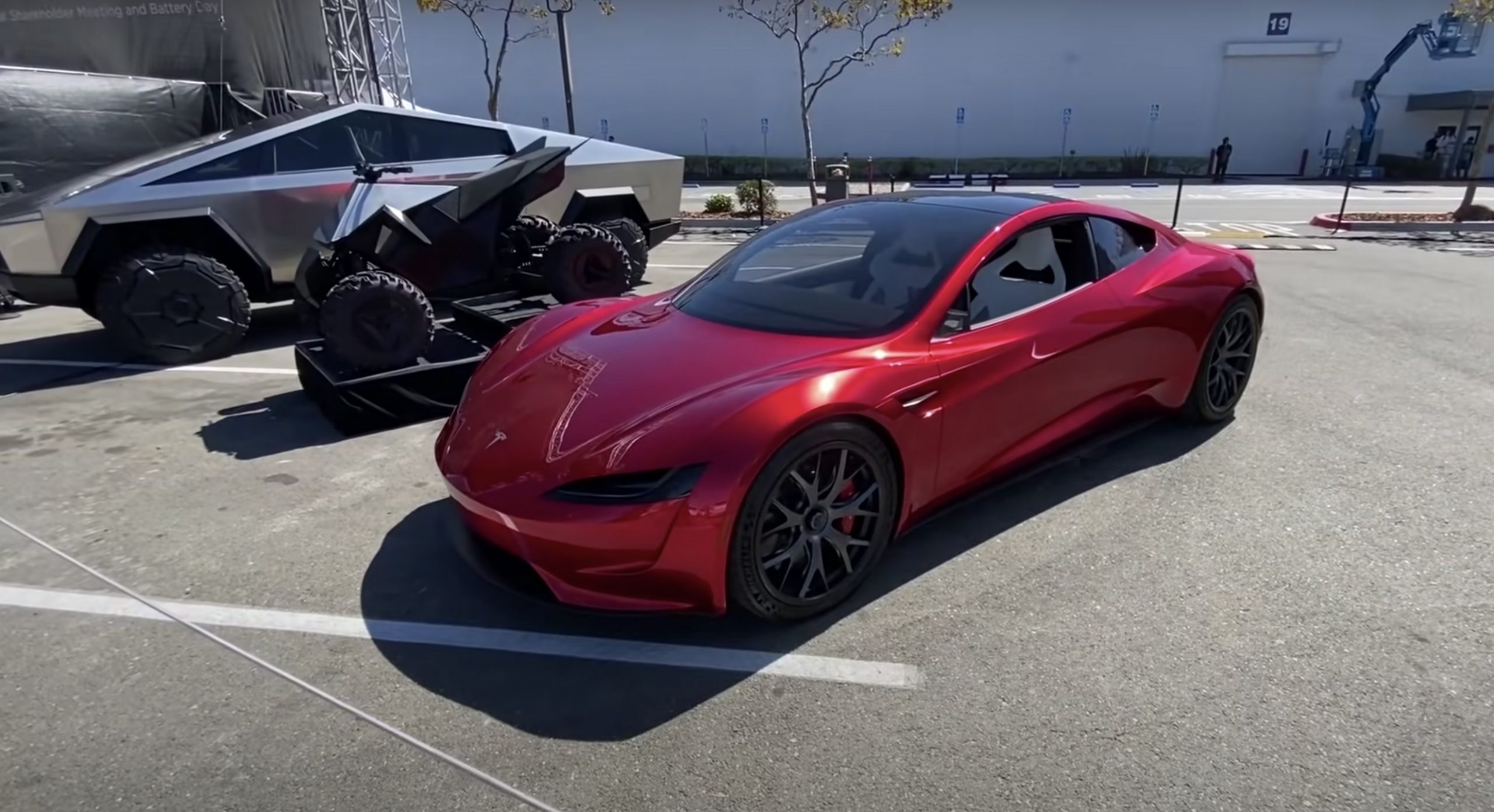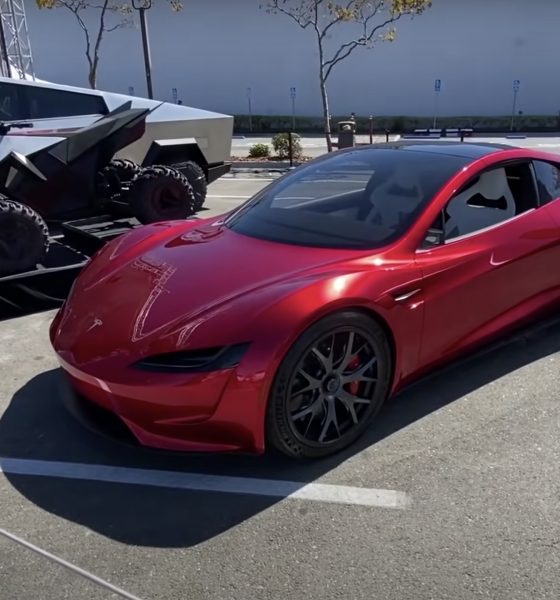

News
Tesla’s Elon Musk highlights that wait for next-gen Roadster ‘will be worth it’
Elon Musk teased that the long wait for Tesla’s next-gen Roadster “will be worth it.” The CEO’s update came as a response to tech YouTuber Marques Brownlee’s tweet about the vehicle, which has seen delays in its deliveries.
Musk and Design Chief Franz von Holzhausen remain tight-lipped about the new Roadster’s improvements, but there is no doubt that it will be astonishing. Since the next-gen Roadster’s unveiling, there have been staggering improvements in Tesla’s other vehicles and the company’s technology, especially in the battery development front.
For instance, the Model S passed the 400 mile EPA range earlier this year and Tesla finally unveiled its own 4680 cell during Battery Day in September. Currently, some specs of the Model S Plaid almost overlap with the base next-gen Roadster.
The base Roadster has a 0-60 mph time of 1.9 seconds, while the Plaid Model S can do it under 2.0 seconds. The numbers speak for themselves. The base Roadster still beats the Plaid Model S in top speed and range, but not by a league. The all-electric supercar has a top speed of +250 mph and a range of 620 miles, while the Plaid Model S has a top speed of 200 mph and an estimated range of 520+ miles.
Then there is the Roadster with the SpaceX Package which will be another variant altogether. The host of YouTube channel Engineering Explained ran the numbers on the Roadster SpaceX Package using Issac Newton’s basic physics principles. He determined that the Roadster could hit 0-60mph in 1.1 seconds with SpaceX thrusters. Without a doubt, that much power will need sufficient energy and may rely heavily on the success of Tesla’s homegrown battery cell.
Elon Musk and Tesla Chief Designer Franz von Holzhausen have dropped some vague hints about the next Roadster over the last two years. In October 2019, Holzhausen teased that Tesla had already made improvements to the Roadster since its unveiling.
“It’s evolving deservedly so; it needs more time. It will be even better than what we’ve unveiled. In every way,” he said during an appearance in Ryan McCaffrey’s Ride the Lightning podcast. Unfortunately, Franz didn’t dive into specific details about the improvements that could be expected in the production version of the all-electric supercar.
Elon Musk said that the Cybertruck production and deliveries may start before the Roadster during an appearance at The Joe Rogan Experience podcast. Gigafactory Texas is expected to start Cybertruck production next year, though Model Y production will likely commence in the complex first. Tesla has been making great progress with the construction of Giga Texas so far.
After Tesla successfully ramps Cybertruck production, it may start working on manufacturing the next-gen Roadster and the Semi. Whether the Roadster’s production will precede the Semi’s remains unclear. Either way, Tesla has a lot of work left before its next-gen Roadster hits the road.
Since its unveiling in November 2017, the Tesla Roadster has been a long-awaited vehicle in the electric car community. Tesla’s next-gen Roadster is quite symbolic for the EV automaker. After all, it was the original Tesla Roadster that really kicked the company into gear so many years ago.
The EV automaker removing the Roadster from the main page of tesla.com may have worried some people, especially considering its historic position at Tesla. The noted tech YouTuber’s tweet about the change probably reflected most of the community’s feelings on the matter. “The Roadster being gone from tesla.com scares me,” Brownlee tweeted, tagging Elon Musk.
The Roadster has been removed from the front page of Tesla’s website, but can still be found using the hamburger menu. Elon Musk’s short reply to Brownlee’s tweet revealed that Tesla has not forgotten about the next-gen Roadster at all. Tesla may simply be waiting for all the pieces to come together before it produces the next iteration of its historic vehicle.

News
Tesla FSD fleet is nearing 7 billion total miles, including 2.5 billion city miles
As can be seen on Tesla’s official FSD webpage, vehicles equipped with the system have now navigated over 6.99 billion miles.

Tesla’s Full Self-Driving (Supervised) fleet is closing in on almost 7 billion total miles driven, as per data posted by the company on its official FSD webpage.
These figures hint at the massive scale of data fueling Tesla’s rapid FSD improvements, which have been quite notable as of late.
FSD mileage milestones
As can be seen on Tesla’s official FSD webpage, vehicles equipped with the system have now navigated over 6.99 billion miles. Tesla owner and avid FSD tester Whole Mars Catalog also shared a screenshot indicating that from the nearly 7 billion miles traveled by the FSD fleet, more than 2.5 billion miles were driven inside cities.
City miles are particularly valuable for complex urban scenarios like unprotected turns, pedestrian interactions, and traffic lights. This is also the difference-maker for FSD, as only complex solutions, such as Waymo’s self-driving taxis, operate similarly on inner-city streets. And even then, incidents such as the San Francisco blackouts have proven challenging for sensor-rich vehicles like Waymos.
Tesla’s data edge
Tesla has a number of advantages in the autonomous vehicle sector, one of which is the size of its fleet and the number of vehicles training FSD on real-world roads. Tesla’s nearly 7 billion FSD miles then allow the company to roll out updates that make its vehicles behave like they are being driven by experienced drivers, even if they are operating on their own.
So notable are Tesla’s improvements to FSD that NVIDIA Director of Robotics Jim Fan, after experiencing FSD v14, noted that the system is the first AI that passes what he described as a “Physical Turing Test.”
“Despite knowing exactly how robot learning works, I still find it magical watching the steering wheel turn by itself. First it feels surreal, next it becomes routine. Then, like the smartphone, taking it away actively hurts. This is how humanity gets rewired and glued to god-like technologies,” Fan wrote in a post on X.
News
Tesla starts showing how FSD will change lives in Europe
Local officials tested the system on narrow country roads and were impressed by FSD’s smooth, human-like driving, with some calling the service a game-changer for everyday life in areas that are far from urban centers.

Tesla has launched Europe’s first public shuttle service using Full Self-Driving (Supervised) in the rural Eifelkreis Bitburg-Prüm region of Germany, demonstrating how the technology can restore independence and mobility for people who struggle with limited transport options.
Local officials tested the system on narrow country roads and were impressed by FSD’s smooth, human-like driving, with some calling the service a game-changer for everyday life in areas that are far from urban centers.
Officials see real impact on rural residents
Arzfeld Mayor Johannes Kuhl and District Administrator Andreas Kruppert personally tested the Tesla shuttle service. This allowed them to see just how well FSD navigated winding lanes and rural roads confidently. Kruppert said, “Autonomous driving sounds like science fiction to many, but we simply see here that it works totally well in rural regions too.” Kuhl, for his part, also noted that FSD “feels like a very experienced driver.”
The pilot complements the area’s “Citizen Bus” program, which provides on-demand rides for elderly residents who can no longer drive themselves. Tesla Europe shared a video of a demonstration of the service, highlighting how FSD gives people their freedom back, even in places where public transport is not as prevalent.
What the Ministry for Economic Affairs and Transport says
Rhineland-Palatinate’s Minister Daniela Schmitt supported the project, praising the collaboration that made this “first of its kind in Europe” possible. As per the ministry, the rural rollout for the service shows FSD’s potential beyond major cities, and it delivers tangible benefits like grocery runs, doctor visits, and social connections for isolated residents.
“Reliable and flexible mobility is especially vital in rural areas. With the launch of a shuttle service using self-driving vehicles (FSD supervised) by Tesla in the Eifelkreis Bitburg-Prüm, an innovative pilot project is now getting underway that complements local community bus services. It is the first project of its kind in Europe.
“The result is a real gain for rural mobility: greater accessibility, more flexibility and tangible benefits for everyday life. A strong signal for innovation, cooperation and future-oriented mobility beyond urban centers,” the ministry wrote in a LinkedIn post.
News
Tesla China quietly posts Robotaxi-related job listing
Tesla China is currently seeking a Low Voltage Electrical Engineer to work on circuit board design for the company’s autonomous vehicles.

Tesla has posted a new job listing in Shanghai explicitly tied to its Robotaxi program, fueling speculation that the company is preparing to launch its dedicated autonomous ride-hailing service in China.
As noted in the listing, Tesla China is currently seeking a Low Voltage Electrical Engineer to work on circuit board design for the company’s autonomous vehicles.
Robotaxi-specific role
The listing, which was shared on social media platform X by industry watcher @tslaming, suggested that Tesla China is looking to fill the role urgently. The job listing itself specifically mentions that the person hired for the role will be working on the Low Voltage Hardware team, which would design the circuit boards that would serve as the nervous system of the Robotaxi.
Key tasks for the role, as indicated in the job listing, include collaboration with PCB layout, firmware, mechanical, program management, and validation teams, among other responsibilities. The role is based in Shanghai.
China Robotaxi launch
China represents a massive potential market for robotaxis, with its dense urban centers and supportive policies in select cities. Tesla has limited permission to roll out FSD in the country, though despite this, its vehicles have been hailed as among the best in the market when it comes to autonomous features. So far, at least, it appears that China supports Tesla’s FSD and Robotaxi rollout.
This was hinted at in November, when Tesla brought the Cybercab to the 8th China International Import Expo (CIIE) in Shanghai, marking the first time that the autonomous two-seater was brought to the Asia-Pacific region. The vehicle, despite not having a release date in China, received a significant amount of interest among the event’s attendees.








